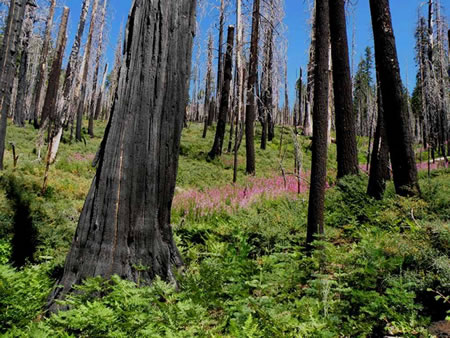|
|
BIOMASS INDUSTRY FANS FLAMES OF WILDFIRE HYSTERIA
(October 2013 - Vol. 4, issue 10)
Biomass Industry Fans Flames of Wildfire Hysteria
California’s Rim fire, expected to be fully "contained" by October after igniting in Yosemite National Park on August 17, will ultimately benefit the forests it has passed through. While media accounts sensationalize such large wildfires as "catastrophic" and "disastrous," science demonstrates that, to the contrary, fire is a vital component of western forest ecosystems.
Journalists mischaracterize the ecological function of wildfire as “devastation” or refer to forests that have experienced fire as a "barren wasteland," exploiting emotions to sell newspapers. Yet media is only an accomplice to one of the masterminds ultimately responsible for fanning the flames of wildfire hysteria: the biomass energy industry.
Ignoring sound science and common sense, the biomass industry insists that cutting more backcountry forests, including native forests, will somehow prevent wildfires and protect people... [READ MORE]

The Ecological Importance of California's Rim Fire
- by Chad Hanson, John Muir Project
Since the Rim fire began in the central Sierra Nevada on August 17, there has been a steady stream of fearful, hyperbolic, and misinformed reporting in much of the media. The fire, which is currently 188,000 acres in size and covers portions of the Stanislaus National Forest and the northwestern corner of Yosemite National Park, has been consistently described as “catastrophic”, “destructive”, and “devastating.” One story featured a quote from a local man who said he expected “nothing to be left.”
However, if we can, for a moment, set aside the fear, the panic, and the decades of misunderstanding about wildland fires in our forests, it turns out that the facts differ dramatically from the popular misconceptions. The Rim fire is a good thing for the health of the forest ecosystem. It is not devastation, or loss. It is ecological restoration... [READ MORE]
Wind Drives All Large Blazes
- by George Wuerthner
As large fires have spread across the West in recent decades, we hear increasing demands to reduce fuels—typically through logging. But logging won’t reduce the large fires we are experiencing because fuels do not drive large fires.
You can have tons of fuel per acre as occurs in Oregon’s Coast Range or the Olympic Mountains of Washington, and have virtually no fires because they are too wet to burn. On the other hand, we have seen some huge acreage charred on overgrazed grasslands that have little more than stubble to burn if there is a major drought and wind.
What makes the difference is not the available fuel, but the climatic/weather conditions. Logging forests does not change the climate/weather... [READ MORE]
 Photo: Doug Bevington
Photo: Doug Bevington
Wildland-Urban Fire: A Different Approach
- by Jack D. Cohen, Rocky Mountain Research Station, U.S. Forest Service
Wildland-urban fire occurs when a fire burning in wildland vegetation fuels gets close enough with its flames and/or firebrands (lofted burning embers) to potentially create ignitions of the residential fuels. Residential fire destruction is the principal problem during wildland-urban fires, but homes that do not ignite do not burn. Recognizing the potential for wildland-urban home ignitions and preventing home ignitions is the principal challenge.
Understanding how homes ignite during wildland-urban fires provides the basis for appropriately assessing the potential for home ignition and thereby effectively mitigating wildland-urban fire ignitions... [READ MORE]
Health Component Missing from Biomass Air Quality Study
- by Diana Somerville
We will soon be making history here on the Olympic Peninsula, or becoming guinea pigs. Thanks to public pressure and legislative support, a two-year study of a unique aspect of our air quality may begin next month. The Olympic Region Clean Air Agency (ORCAA), working with University of Washington atmospheric scientists, will look at changes downwind from biomass cogeneration plants adjacent to the existing paper mills in Port Angeles and Port Townsend. These plants will generate electricity by burning smaller trees and forestry waste with construction and demolition debris often added to the mix.
Nippon in Port Angeles and Port Townsend Paper are the major, easily identified sources of pollution in each community’s relatively clean air. Neither mill has yet fired up its biomass incinerator -- and that provides a unique opportunities to study significant, and as-yet-unexamined aspects of their impact on the quality of our air... [READ MORE]
Biomass Energy Never Carbon Neutral
- by Karen Orr, Energy Justice Network
Biomass energy is not carbon neutral and never will be.
For years scientific studies have shown that biomass energy isn't carbon neutral in any useful time frame. A 2012 study from Norway demonstrates that logging forests for bio-energy leads to a permanent increase in atmospheric carbon dioxide. Expansion of industrial scale biomass energy will exacerbate climate change.
Fueling biomass operations adds carbon to the atmosphere at the smokestack. Increased biomass removals escalates stress to forests and soils and reduces long term growth rates, thus also adding to atmospheric carbon levels by absorbing less... [READ MORE]
|
|
|
|
|
|
|